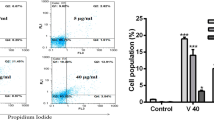Abstract
Malignant gliomas are rarely curable malignant tumors in the central nervous system. Chlorotoxin (CTX) is a peptide derived from scorpion venom, which can selectively target malignant gliomas. Onconase (Onc) is a small cytotoxic ribonuclease derived from frogspawn that exhibits cytotoxicity against some tumor cells. In the present study, we found that CTX-conjugated Onc (CTX–Onc) shows better anti-tumor effect than the physical mixture of CTX and Onc (CTX + Onc) on the nude mice carrying subcutaneous glioblastoma cell-derived tumor. However, CTX–Onc does not show dose-dependent anti-tumor effect. In addition, apoptosis in tumor tissue does not show significant difference between the treatment groups. Our results confirmed that CTX–Onc has better anti-tumor effect than CTX + Onc and suggest that it can be potentially used for glioma therapy.



Similar content being viewed by others
References
Adamson, C., Kanu, O. O., Mehta, A. I., Di, C., Lin, N., Mattox, A. K., & Bigner, D. D. (2009). Glioblastoma multiforme: A review of where we have been and where we are going. Expert Opinion on Investigational Drugs, 18, 1061–1083.
Gilbert, M. R., Dignam, J. J., Armstrong, T. S., Wefel, J. S., Blumenthal, D. T., Vogelbaum, M. A., et al. (2014). A randomized trial of bevacizumab for newly diagnosed glioblastoma. New England Journal of Medicine, 370, 699–708.
Lima, F. R., Kahn, S. A., Soletti, R. C., Biasoli, D., Alves, T., da Fonseca, A. C., et al. (2012). Glioblastoma: therapeutic challenges, what lies ahead. Biochimica et Biophysica Acta, 1826, 338–349.
Watkins, S., & Sontheimer, H. (2012). Unique biology of gliomas: Challenges and opportunities. Trends in Neurosciences, 35, 546–556.
DeBin, J. A., Maggio, J. E., & Strichartz, G. R. (1993). Purification and characterization of chlorotoxin, a chloride channel ligand from the venom of the scorpion. American Journal of Physiology, 264, C361–C369.
Lyons, S. A., O’Neal, J., & Sontheimer, H. (2002). Chlorotoxin, a scorpion-derived peptide, specifically binds to gliomas and tumors of neuroectodermal origin. Glia, 39, 162–173.
Deshane, J., Garner, C. C., & Sontheimer, H. (2003). Chlorotoxin inhibits glioma cell invasion via matrix metalloproteinase-2. Journal of Biological Chemistry, 278, 4135–4144.
Kesavan, K., Ratliff, J., Johnson, E. W., Dahlberg, W., Asara, J. M., Misra, P., et al. (2010). Annexin A2 is a molecular target for TM601, a peptide with tumor-targeting and anti-angiogenic effects. Journal of Biological Chemistry, 285, 4366–4374.
Polivka, J, Jr, Rohan, V., Topolcan, O., & Ferda, J. (2012). New molecularly targeted therapies for glioblastoma multiforme. Anticancer Research, 32, 2935–2946.
Veiseh, M., Gabikian, P., Bahrami, S. B., Veiseh, O., Zhang, M., Hackman, R. C., et al. (2007). Tumor paint: A chlorotoxin: Cy5.5 bioconjugate for intraoperative visualization of cancer foci. Cancer Research., 67, 6882–6888.
Fu, Y., An, N., Li, K., Zheng, Y., & Liang, A. (2012). Chlorotoxin-conjugated nanoparticles as potential glioma-targeted drugs. Journal of Neuro-oncology, 107, 457–462.
Darzynkiewicz, Z., Carter, S. P., Mikulski, S. M., Ardelt, W. J., & Shogen, K. (1988). Cytostatic and cytotoxic effects of Pannon (P-30 protein), a novel anticancer agent. Cell Tissue Kinet, 21, 169–182.
Ardelt, W., Mikulski, S. M., & Shogen, K. (1991). Amino acid sequence of an anti-tumor protein from Rana pipiens oocytes and early embryos. Homology to pancreatic ribonucleases. Journal of Biological Chemistry, 266, 245–251.
Wu, Y., Mikulski, S. M., Ardelt, W., Rybak, S. M., & Youle, R. J. (1993). A cytotoxic ribonuclease. Study of the mechanism of onconase cytotoxicity. Journal of Biological Chemistry, 268, 10686–10693.
Saxena, S. K., Sirdeshmukh, R., Ardelt, W., Mikulski, S. M., Shogen, K., & Youle, R. J. (2002). Entry into cells and selective degradation of tRNAs by a cytotoxic member of the RNase A family. Journal of Biological Chemistry, 277, 15142–15146.
Suhasini, A. N., & Sirdeshmukh, R. (2006). Transfer RNA cleavages by onconase reveal unusual cleavage sites. Journal of Biological Chemistry., 281, 12201–12209.
Pavlakis, N., & Vogelzang, N. J. (2006). Ranpirnase—an antitumour ribonuclease: Its potential role in malignant mesothelioma. Expert Opinion on Biological Theraphy, 6, 391–399.
Lee, I., Kalota, A., Gewirtz, A. M., & Shogen, K. (2007). Antitumor efficacy of the cytotoxic RNase, ranpirnase, on A549 human lung cancer xenografts of nude mice. Anticancer Research, 27, 299–307.
Wang, X. M., Luo, X., & Guo, Z. Y. (2013). Recombinant expression and downstream processing of the disulfide-rich tumor-targeting peptide chlorotoxin. Experimental and Therapeutic Medicine, 6, 1049–1053.
Wang, Xiaomin, & Guo, Zhanyun. (2013). Recombinant expression, different downstream processing of the disulfide-rich anti-tumor peptide Ranpirnase and its effect on the growth of human glioma cell line SHG-44. Biomedical Reports, 1(5), 747–750.
Wang, X., & Guo, Z. (2015). Chlorotoxin-conjugated onconase as a potential targeted anti-glioma drug. Oncology Letters., 9, 1337–1342.
Cheng, Y., Zhao, J., Qiao, W., & Chen, K. (2014). Recent advances in diagnosis and treatment of gliomas using chlorotoxin-based bioconjugates. American Journal of Nuclear Medicine and Molecular Imaging., 4, 385–405.
Acknowledgments
This work was supported by the Chinese Major Scientific and Technological Special Project for “Major New Drugs Creation” (2009ZX09103-656).
Conflict of interest
We have no conflict of interest to declare.
Author information
Authors and Affiliations
Corresponding author
Rights and permissions
About this article
Cite this article
Wang, X., Guo, Z. Anti-gliomas Effect of Chlorotoxin-Conjugated Onconase at High Dose. Cell Biochem Biophys 73, 389–392 (2015). https://doi.org/10.1007/s12013-015-0634-4
Published:
Issue Date:
DOI: https://doi.org/10.1007/s12013-015-0634-4




